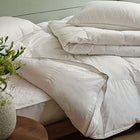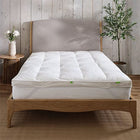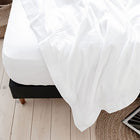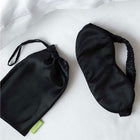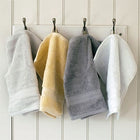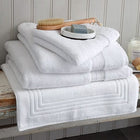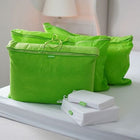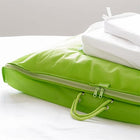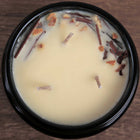
Is there plastic in your bedding?
There are so many choices to make when you buy new bedding and your main considerations are probably: will it help you sleep better and is it value for money? How often do we stop to think about the amount of plastic in our bedding and the impact that it might have on the environment before and after use?
We thought we'd take a look.
- Sources of plastics in bedding
- Polyester used in microfibre and hollowfibre bedding
- Microfibre pollution from bedding
- Memory foam bedding
- Environmental impact
- Go plastic free with Scooms bedding
- Top tips for a plastic free sleep
- Key plastic pollution facts
Sources of plastic in bedding
Whether it's duvets, pillows, mattresses or even bed linen, most of us are unaware of how much plastic is in our bedding. And with a never-ending list of options, it has become more and more confusing to know how to buy the right sleep essentials whilst ensuring that we're all doing our part for the environment.
We've identified that the three main sources of plastic in bedding are:
- The synthetic fibres used to make synthetic filled bedding.
- The plastic packaging bedding comes in.
- Memory foam.
Polyester used in microfibre and hollowfibre bedding
The most common plastic found in bedding is polyester. There are many different types of polyester, but the most prevalent used in bedding is Polyethylene Terephthalate or PET. This is made from a series of chemical processes at very high temperatures using lots of energy, as well as substances extracted from oil and sometimes coal.
The very fine, synthetic fibres produced were created as a man-made equivalent to natural down. Called microfibre, hollowfibre or 'Soft As Down', they are cheap to mass produce in vast quantities.
Microfibre pollution from bedding
Microfibres are microscopic pollutants. As well as polluting the environment during the manufacturing process by using lots of energy, high temperatures and chemical catalysts, these microfibres, like other micro-plastics, can enter our rivers, seas and land food chains, as well as being present in the very air we breathe. Microfibres account for 85% of man-made debris.
Memory foam bedding
Also known as viscoelastic foam, memory foam can be found in pillows, mattresses and toppers. It was developed in 1965 by NASA to improve the safety of aircraft cushions. Memory foam is typically a type of polyurethane plastic. It is produced by an exothermic reaction between two petroleum or plant-based oils, polyols, isocyanates and reacting agents. Other additives such as flame retardants and formaldehyde-based adhesives can also be used, which may also be hazardous to the environment.
It's not uncommon to notice a chemical off-gas smell when unpacking memory foam products. Caused by VOCs, (volatile organic compounds), these have been linked to a host of respiratory health problems. Memory foam products can continue to emit gasses even after a gassing off period.
Environmental impact of plastics from bedding
Nearly 70 million barrels of oil is used each year to make polyester globally. It's a non-renewable, carbon-intensive resource that has a huge environmental impact.
Currently there are very few places where duvets and pillows made from microfibres and memory foam can be recycled. They typically end up in landfill or in the sea.
Many duvets and pillows also arrive wrapped in single use plastic packaging, which almost always ends up in our seas or in landfill.
“We have to act now to try and clear up some of the appalling damage we have made… and that is going to require positive action,” Sir David Attenborough.
Scooms bedding
When we developed the Scooms bedding range, we aimed to make sure that no toxins or chemicals were used in the production of our duvets, pillows and bed linen.
Our bedding is all made from natural, biodegradable materials. And we don't use any unnecessary single use plastics in our packaging. We deliver all our products in reusable fabric bags and recyclable cardboard boxes.
Our top tips for plastic-free sleep:
- Opt for duvets and pillows made from natural materials such as goose down and wool - they are biodegradable and use less energy in production.
- Buy well and buy once. Invest in the best quality natural duvet and pillow you can and avoid bedding that is wrapped in single-use plastics.
- When your natural duvet or pillow comes to the end of it's lifecycle, you can put the feathers and wool out for nesting birds.
- If synthetic bedding is a must, then opt for recycled microfibre which is made from waste plastic PET bottles, using less energy to produce and reducing landfill.
- If you're considering memory foam pillows/mattresses, then take a closer look at what they are made of to avoid any chemical nasties such as VOCs.
- Reduce the number of times you wash a synthetic pillow or duvet to avoid it potentially shedding microfibres and introducing these into the water.
- Avoid disposing of your synthetic mattress in landfill. If it's in good condition, donate it to a charity who will recycle and reuse it. Many local authorities do not recycle old duvets, so the best advice is to put it out of the way in your loft - it may even add a little insulation.
Key plastic pollution facts
- Synthetic fibres represent one of the main forms of microplastics in the marine environment. “Of the pollution from microplastics, 71% are fibres, whilst 29% are other things like microbeads from toothpaste and facial scrubs or little fragments of mystery particles," says Peter Ross, VP of research at Ocean Wise.
- Because they are so small, treatment plants cannot effectively filter out all microfibres. Instead, many are released into the environment. A study by Patagonia and the University of California, Santa Barbara, on the microfibre in clothing, found that up to 40% of microfibres in wastewater ends up entering rivers, lakes, and oceans.
- Zooplankton and other small organisms ingest microfibres, which then make their way up the food chain. Researchers have found high numbers of fibres inside fish and shellfish sold for human consumption. In one survey reported in Nature, the majority of micro pollutants were microfibres from textiles.
- Microplastics have been found in over 100 marine species, from zooplankton to whales, including mussels, crabs, fish, sharks, sea reptiles and seabirds.
- Synthetic fibres act as a magnet for harmful chemical pollutants in the environment such as pesticides or flame retardants. When marine organisms ingest the micro plastics, they also ingest the pollutants.
- Fibres retained in wastewater treatment sludge (bios solids) that are land-applied can persist in soils.
- Microfibres can fragment, become airborne and be inhaled. Airborne fibrous microplastics may also carry pollutants.
- We don't really know how long it takes for plastic to break down. It's estimated that it could take thousands of years to degrade or may never truly degrade.
- According to a recent study from Plymouth University, each cycle of a washing machine can release more than 500,000 plastic fibres into the environment.
- If plastic consumption increases at its current rate, according to National Geographic, by 2050 there will be 12 billion metric tons of plastic in landfills.
- A paper published in 2011 in the journal Environmental Science Technology, found that microfibres made up 85% of human-made debris on shorelines around the world.
- The term Anthropogenic is used to mean environmental pollution and pollutants originating in human activity.
- The Great Pacific Garbage Patch area of ocean approx.1.6 million km2 is more of a plastic soup than a plastic island. An article in Nature estimates that it consists of 1.8 trillion plastic pieces, the majority of which are microplastics: o 1.7 trillion pieces of microplastics (0.05–0.5 cm) o 56 billion pieces of mesoplastics (0.5–5 cm) o 821 million pieces of macroplastics, (5–50 cm) o 3.2 million pieces of megaplastics (>50 cm).
- It’s estimated that fibres are, by count, the single largest contributor to watershed plastic pollution in developed countries and account for a significant portion of plastic waste entering the ocean.
- Every year 14 million duvets, pillows and mattress toppers end up in UK landfills.
- Around 61,900 tonnes of duvets and pillows enter the waste system in the UK each year.
